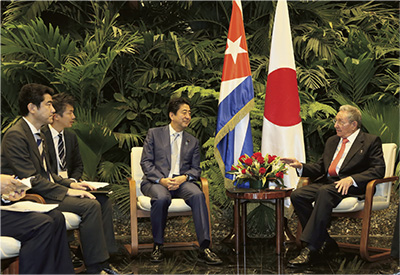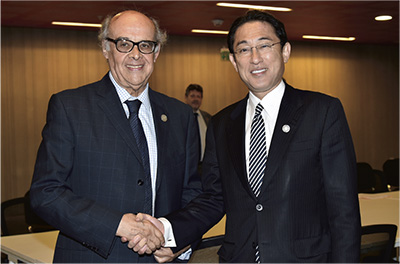Diplomatic Bluebook 2017
Chapter 2
Japan's Foreign Policy that Takes a Panoramic Perspective of the World Map
Section 3 Latin America and the Caribbean
Overview
The Latin America and the Caribbean region, with its enormous economic potential, is a major force in the international arena sharing basic values with Japan, and is a key partner for Japan with the largest number of Japanese descendants in the world. This region has a population of approximately 600 million, containing an enormous market with a combined GDP of approximately 5.1 trillion US dollars (approximately two times larger than that of Association of Southeast Asian Nations (ASEAN)). The region also has large amounts of rare metals and shale gas, and produces minerals, energy and food, which, in recent years, have led a significant number of Japanese companies to establish operations in the region. Moreover, with the rule of law and democracy firmly established, the region has a strong presence in the international community. Japan and Latin America and the Caribbean region have traditionally maintained a stable and friendly relationship for a long time. The existence of over 2.13 million Japanese descendants, called “Nikkeis”, living in Latin America, have made the bonds even deeper.
 Japan-Cuba Summit Meeting (September 22, Cuba; Photo: Cabinet Public Relations Office)
Japan-Cuba Summit Meeting (September 22, Cuba; Photo: Cabinet Public Relations Office)In 2014, Prime Minister Abe paid official visits to five countries in the region. During this trip, the Prime Minister announced three guiding principles of Japan's diplomacy for Latin America and the Caribbean: (1) Progress together (strengthening economic relations); (2) Lead together (working together with the international community); and (3) Inspire together (promoting people-to-people exchanges, and cultural and sports exchanges). Based on these principles, Japan is strengthening the ties with the region.
In 2016, Japan's diplomacy directed at Latin America and the Caribbean was particularly remarkable. Prime Minister Abe visited Rio de Janeiro (Brazil) in August to attend the closing ceremony for the Olympic Games, which was followed by the first sitting prime minister's visit to Cuba in September. Furthermore, in November he attended the APEC Economic Leaders' Meeting in Peru as well as paid an official visit there; moreover he became the first sitting prime minister to visit Argentina for the first time in 57 years. From Latin America and the Caribbean Countries, President Varela of Panama visited Japan in April and President Temer of Brazil visited Japan in October.
 Meeting between Foreign Minister Luna of Peru and Foreign Minister Kishida (November 17, Peru)
Meeting between Foreign Minister Luna of Peru and Foreign Minister Kishida (November 17, Peru)Foreign Minister Kishida also visited Peru to attend APEC in November, holding a meeting with Foreign Minister Luna of Peru. In addition, he held meetings with Foreign Minister Loizaga of Paraguay in March, Foreign Minister Martínez of El Salvador in May, Foreign Minister Malcorra of Argentina in July, and Minister of Foreign Affairs and Foreign Trade Johnson Smith of Jamaica in December. In September he took the opportunity of the United Nations General Assembly to hold the Japan-CARICOM Ministerial-Level Conference. Thus, the exchanges between Japan and Latin America and the Caribbean Countries were extremely vigorous in 2016 and initiatives for overcoming geographical constraints were carried out.
Regarding economic aspects, a variety of initiatives have been implemented for the improvement of the business environment in Latin America and the Caribbean in order to support Japanese companies. In January the Consulate-General of Japan in León was opened in Guanajuato State, Mexico, where the influx of Japanese companies, particularly in the automobile industry, and increase in the number of Japanese residents is remarkable. In November the Second Japan-Cuba Joint Public-Private Committee Meeting was held in Tokyo and in Argentina, taking the opportunity of the visit of Prime Minister Abe to that country, an Economic Forum was held with the participation of 500 people. Moreover at the Japan-Peru Summit Meeting in November, the leaders decided to commence consultations regarding a Japan-Peru convention for the avoidance of double taxation and in addition in December the Tax Convention with Chile entered into force.
 Prime Minister Abe shaking hands with President Macri of Argentina (November 21, Argentina; Photo: Cabinet Public Relations Office)
Prime Minister Abe shaking hands with President Macri of Argentina (November 21, Argentina; Photo: Cabinet Public Relations Office)The year 2016 is the 80th anniversary of Japanese immigration to Paraguay, so a variety of commemoration ceremonies were held. In addition this year also marked the 60th anniversary of the establishment of diplomatic relations between Japan and Haiti and the 60th anniversary of Japanese immigration to the Dominican Republic.
